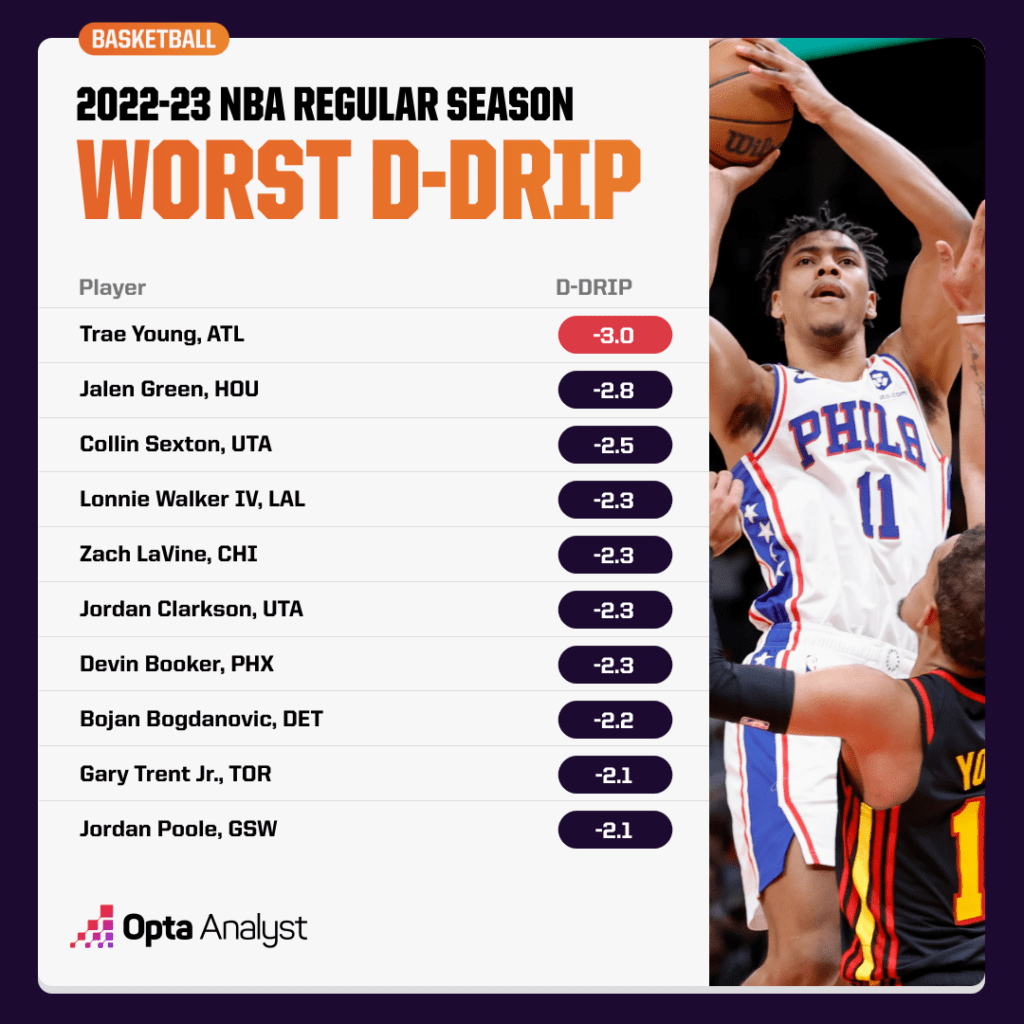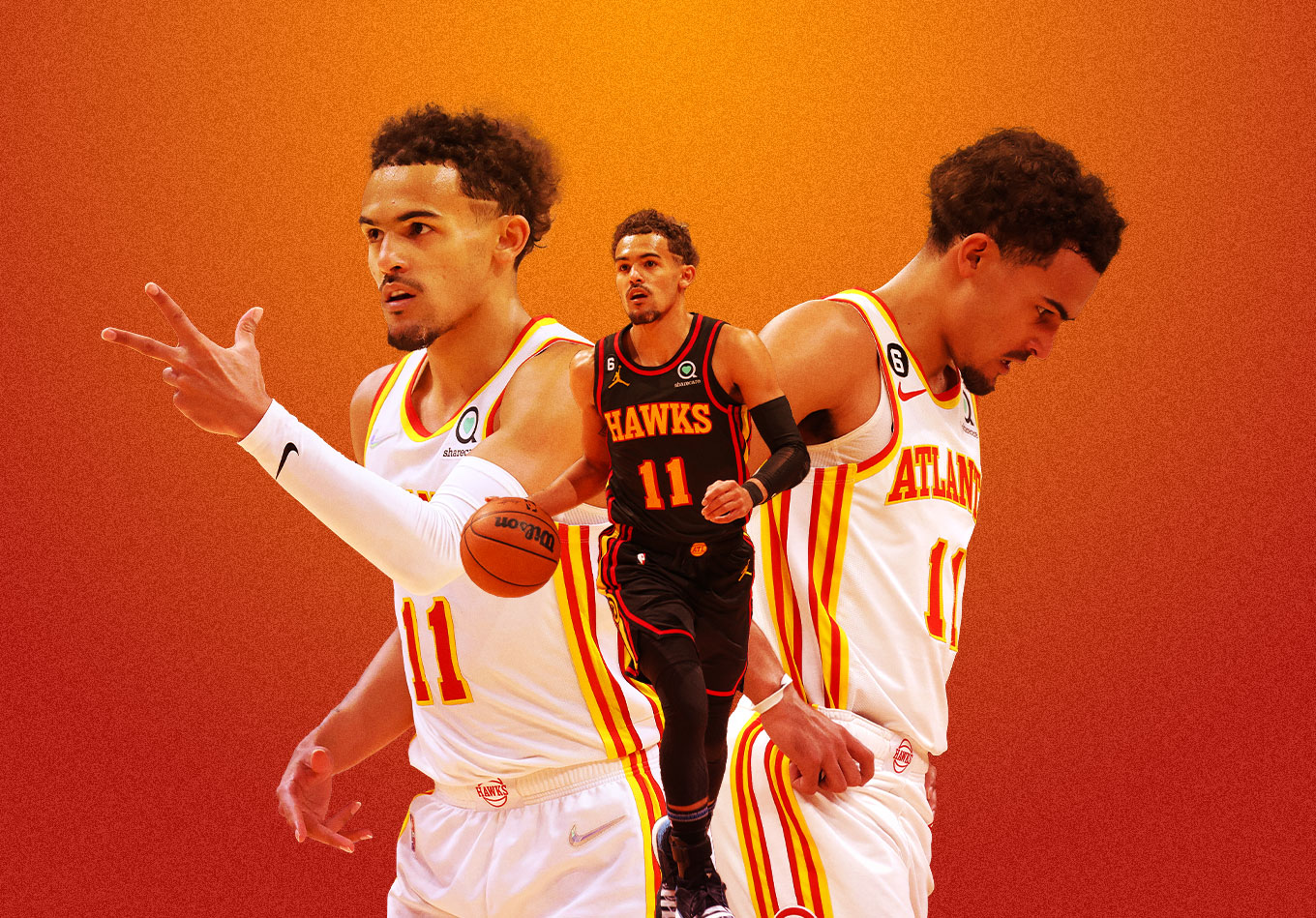After making the Eastern Conference finals in 2021, the Atlanta Hawks have lost six of their last seven playoff games over the span of the last two seasons.
That fact, coupled with All-Star guard Trae Young’s well-documented struggles in those games (and recent rumors surrounding his potential availability this offseason), has many wondering if he’s the one responsible for the team’s recent stretch of disappointment.
What’s going on with Young? Is it all his fault?
And what does this current situation tell us about a team’s chances of building around this polarizing point guard?
What’s on Young?
Young isn’t just a poor defender, he’s a historically awful one.
Of the 508 players who have graced the hardwood this season, Young ranks dead last with a minus-3.0 defensive DRIP, our catch-all defensive metric.

And if a layperson could figure this out in a matter of minutes by using our DRIP leaderboard, you best believe the Boston Celtics (the presumptive NBA title favorites) are well aware of this factoid.
As a result, they have spent a large portion of Young’s minutes in this series finding creative ways to involve him in the primary actions to exploit his defensive shortcomings.
Some of Young’s problems are due to his physical limitations. At 6-foot-1 (with a 6-foot-2 wingspan) and just a shade over 160 pounds, Young is ill-equipped to deal with Boston’s cavalcade of brutish guards and forwards.
However, not all of Young’s defensive problems can be blamed on his genetics. He’s often prone to off-ball blunders, silly fouls and unnecessary gambles. These are things that are within his control that he can tighten up to mitigate the damage he does on that end of the court.
Another negative consequence of his slight build is that Young struggles against defenses that tout a ton of length. This weakness is becoming increasingly more damaging as the league continues to prioritize length in the space-ball era.
Those same guards and forwards who have spent the first two games bullying Young when he’s on defense have not relented in their approach when it becomes time for them to guard him.
The Celtics have a great job of swarming Young with length at the point of attack, shrinking his driving lanes and blurring his sight lines.
Through the first two games of the series, Young has been held to 40 points and 14 assists while he’s also committed 10 turnovers and posted a horrid 43.7 true shooting percentage (if this were the regular season, that would be the worst mark in the league).
It also doesn’t help Young’s case that when the ball isn’t in his possession, he has been incredibly docile on offense. Although, one can only imagine how exhausted he must be after all the trials and tribulations Boston’s offense and defense have forced him to endure.
(Sidebar: This year, many teams have caught on to Young’s issues dealing with length. All year, teams have been throwing similar looks as what the Celtics have been throwing at him. Dealing with this for extended stretches can be both physically and mentally draining and could be partially contributing to his dip in 3-point shooting – hard to launch it from deep with tired legs).
What’s Not on Young?
One commonality the 2022-23 Celtics and 2021-22 Miami Heat share is that they are/were top seeds in the East. You can try and say that if Young was so great, his team would be a higher seed.
But at the end of the day, Atlanta keeps drawing tough first-round opponents because it is an inherently flawed unit overall.
For instance, yes, Young has been getting cooked off the dribble against Boston. But he’s not the only one this is happening to; guys like Saddiq Bey, John Collins and De’Andre Hunter have all been getting beaten at the point of attack in this series.
Clint Capela and Onyeka Okongwu are both good defensive big men. But if you are going to have so many holes to poke at on the perimeter, you need great (we’re talking peak Rudy Gobert level) defensive anchors to accommodate for all the spillage that is inevitably going to take place.
Young’s a bad defender, but the Hawks have done him no favors by putting a poor defensive infrastructure around him. According to our adjusted defensive ratings, Atlanta was 23rd in the league on defense during the regular season. No matter how you slice it, that’s not all on Young.
Last season, we cataloged how the Heat took advantage of Atlanta’s lack of secondary creation by continuously blitzing and trapping Young whenever he had the ball in his hands. To remedy that in the offseason, the Hawks went out and traded for Dejounte Murray.
Now, if a team tries to trap Young, he can fling the ball over to Murray and let him take advantage of a 4-on-3 power play. The Celtics know this and have instead decided to turn to drop coverage – with a twist.
Against pick-and-roll, Boston is bringing a third defender into the drop coverage (a practice that has grown in popularity this season) to help pack the paint and (like we said) shrink Young’s driving lanes.
The reason Boston can get away with this strategy is that Atlanta doesn’t have the shooting necessary to make the Celtics pay for overhelping on Young’s drives. On the year, Atlanta is 26th in 3-point makes per game (10.8), 28th in 3-point attempts (30.5) and 21st in 3-point percentage (35.2%).
Last season, with better perimeter personnel, those marks were 11th (12.9), 18th (34.4), and 2nd (37.4%).
So by bringing in Murray (and also trading away Kevin Huerter), Atlanta has essentially exchanged one weakness (secondary ball handling) for another (spacing/shooting).
What Can Be Done?
Every time a player of Young’s caliber struggles like this on such a big stage, everyone wants to embark on this wide-scale overcorrection, claiming that the player who has been voted as an All-Star (twice) and nominated to an All-NBA team is somehow actually a negative player.
And that just isn’t the case.
Young, more than anything, is a player with massive tradeoffs. On one hand, he is one of the best offensive floor-raisers in the game. This season, he’s fifth in the entire league in offensive DRIP (plus-4.7). And, despite their poor shooting and a midseason coaching change, he’s helped Atlanta rank sixth in the NBA in adjusted offensive rating.
On the other hand, you need to surround him with complimentary players who defend well enough to protect him from the opposition and can also shoot accurately enough to enable him to navigate through an uncongested paint.
The correct thing to say about Young is that you have less margin for error when it comes to building a winner around him than you would with other stars.
That doesn’t mean you can’t win with him. You definitely still can. In fact, Atlanta can still win with Young if it’s willing to clean up the flaws we’ve identified without losing too much secondary ball handling in the process.
But, if the Hawks are unable to address these issues (or just unwilling to), maybe they’re better off moving him to a team that can and will.
Enjoy this? Subscribe to our mailing list to receive exclusive weekly content.
